Halogen reactions - Study guides, Class notes & Summaries
Looking for the best study guides, study notes and summaries about Halogen reactions? On this page you'll find 197 study documents about Halogen reactions.
Page 4 out of 197 results
Sort by
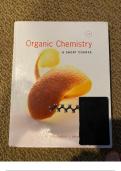
-
Organic Chemistry A Short Course 13Th Ed By Hart - Test Bank
- Exam (elaborations) • 260 pages • 2023
-
- $26.67
- + learn more
Chapter 3 -- Alkenes and Alkynes MULTIPLE CHOICE 1. Which of the following dienes can be classified as conjugated? A) CH3CH=C=CH2 B) CH3CH=CHCH=CH2 C) CH2=CHCH2CH=CH2 D) CH3CH=CHCH2CH2CH=CH2 E) CH2=C=CH2 ANS: B TOP: Alkenes and Alkynes: Nomenclature and Structure 2. Which of the following molecular formulas could not represent an alkene? A) C5H10 B) C7H14 C) C10H20 D) C27H56 E) C31H62 ANS: D TOP: Alkenes and Alkynes: Nomenclature and Structure 3. What...
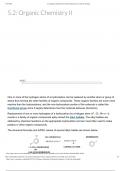
-
5.2: Organic Chemistry II
- Summary • 4 pages • 2024
-
- $17.99
- + learn more
5.2: Organic Chemistry II One or more of the hydrogen atoms of a hydrocarbon can be replaced by another atom or group of atoms thus forming the other families of organic compounds. These organic families are much more reactive than the hydrocarbons, and the non-hydrocarbon portion of the molecule is called the functional group since it largely determines how the molecule behaves (functions). Replacement of one or more hydrogens of a hydrocarbon by a halogen atom (-F, -Cl, -Br or –I) resu...

-
CHEM 210 Final Exam Study Guide Exam 1 Final Review Questions with Answers
- Exam (elaborations) • 18 pages • 2023
-
Available in package deal
-
- $10.99
- + learn more
What are the differences between aliphatic (including alkanes, alkenes,alkynes and cyclic compounds) aromatic hydrocarbons are. - ALIPHATIC Hydrocarbon: Non-aromatic -Alkanes & CycloAlkanes:single bonds; saturated:Contain only carbon and hydrogen & C-C & C-H single bonds -Alkenes:double bond(s) -Alkynes: triple bond(s) *alkenes and alkynes are unsaturated: at least one C-C double or triple bond(s) AROMATIC Hydrocarbon: benzene ring What is the trend in solubility and boiling point/mel...
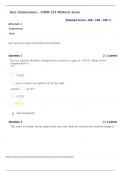
-
CHEM133 Week 7 Midterm Exam (Spring) Questions and Answers APU
- Exam (elaborations) • 26 pages • 2023
- Available in package deal
-
- $32.99
- + learn more
1. Question: Dry ice (carbon dioxide) changes from a solid to a gas at –78.5°C. What is this temperature in °F? 2. Question: The state of matter for an object that has both definite volume and definite shape is 3. Question: In 1828, the diameter of the U.S. dime was changed to approximately 18 mm. What is this diameter when expressed in nanometers? 4. Question: A piece of antimony with a mass of 17.41 g is submerged in 46.3 cm3 of water in a graduated cylinder. The water level increases t...
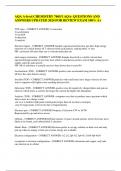
-
AQA A-level CHEMISTRY 7405/1 AQA- QUESTIONS AND ANSWERS UPDATED 2024 FOR REVIEW EXAM 100% A+
- Exam (elaborations) • 35 pages • 2024
-
- $4.89
- + learn more
TOF steps - CORRECT ANSWER-1) ionisation 2) acceleration 3) ion drift 4) detection 5) analysis Electron impact - CORRECT ANSWER-Sample vaporised and electron gun fires high energy electrons at it which knock off 1 electron from each particle, making them 1+ ions NB- can knock off more than one e or break molecular ion electrospray ionization - CORRECT ANSWER-Sample dissolved in volatile solvent then injected through needle to give fine mist which is attached to positive end of high v...
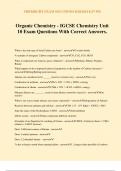
-
Organic Chemistry - IGCSE Chemistry Unit 10 Exam Questions With Correct Answers.
- Exam (elaborations) • 7 pages • 2024
-
- $11.49
- + learn more
Organic Chemistry - IGCSE Chemistry Unit 10 Exam Questions With Correct Answers. What is the only type of bond Carbon can form? - answerCovalent bonds 4 examples of inorganic Carbon compounds - answerCO, CO2, CO3, HCO3 What 4 compounds are found as gases (Alkanes)? - answerMethane, Ethane, Propane, Butane What happens to the compound's physical properties as the number of Carbons increases? - answerMelting/Boiling point increases Alkanes are considered to be ______ reactive (very/not ve...
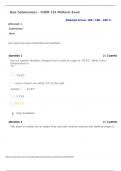
-
CHEM133 Week 7 Midterm Exam (All Correct)
- Exam (elaborations) • 26 pages • 2023
-
Available in package deal
-
- $35.48
- + learn more
1. Question: Dry ice (carbon dioxide) changes from a solid to a gas at –78.5°C. What is this temperature in °F? 2. Question: The state of matter for an object that has both definite volume and definite shape is 3. Question: In 1828, the diameter of the U.S. dime was changed to approximately 18 mm. What is this diameter when expressed in nanometers? 4. Question: A piece of antimony with a mass of 17.41 g is submerged in 46.3 cm3 of water in a graduated cylinder. The water level increases t...
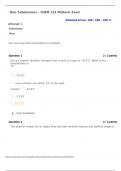
-
CHEM133 Week 7 Midterm Exam (Spring)
- Exam (elaborations) • 26 pages • 2023
- Available in package deal
-
- $39.99
- + learn more
1. Question: Dry ice (carbon dioxide) changes from a solid to a gas at –78.5°C. What is this temperature in °F? 2. Question: The state of matter for an object that has both definite volume and definite shape is 3. Question: In 1828, the diameter of the U.S. dime was changed to approximately 18 mm. What is this diameter when expressed in nanometers? 4. Question: A piece of antimony with a mass of 17.41 g is submerged in 46.3 cm3 of water in a graduated cylinder. The water level increases t...

-
chem 210 exam 3 with all questions correctly answered
- Exam (elaborations) • 5 pages • 2023
-
Available in package deal
-
- $13.49
- + learn more
less the more s character a carbocation has, the _____stable it is the same as when looking at an epoxide, the orientation around the oxygen is _________ the orientation around the double bond in the reactant BrOH when added with base makes an epoxide Br2 adds 2 Brs in anti conformation lindlar catalyst produces a Z alkene from an alkyne (adds 2 Hs in syn) add more electronegative atom, add pi bond 2 ways of producing an oxidation reaction remove e...
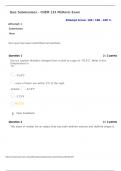
-
CHEM133 Week 7 Midterm Exam (Spring)
- Exam (elaborations) • 26 pages • 2023
-
- $31.49
- + learn more
1. Question: Dry ice (carbon dioxide) changes from a solid to a gas at –78.5°C. What is this temperature in °F? 2. Question: The state of matter for an object that has both definite volume and definite shape is 3. Question: In 1828, the diameter of the U.S. dime was changed to approximately 18 mm. What is this diameter when expressed in nanometers? 4. Question: A piece of antimony with a mass of 17.41 g is submerged in 46.3 cm3 of water in a graduated cylinder. The water level increases t...

Did you know that on average a seller on Stuvia earns $82 per month selling study resources? Hmm, hint, hint. Discover all about earning on Stuvia


